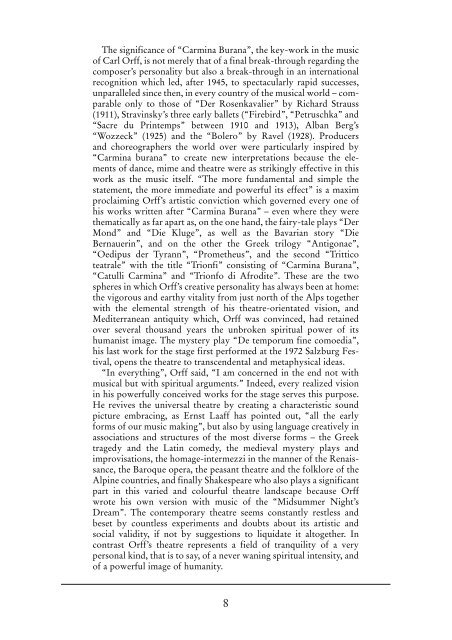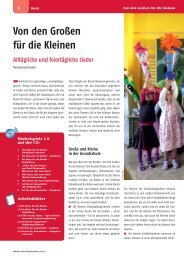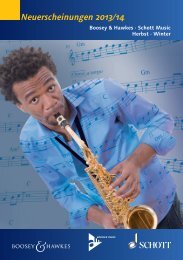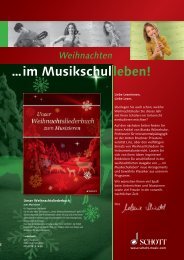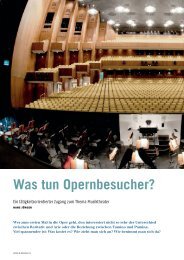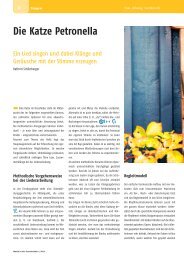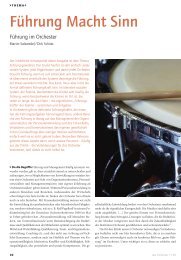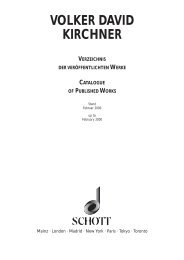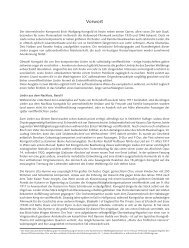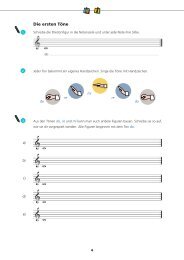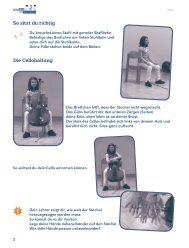Katalog als PDF herunterladen - Schott Music
Katalog als PDF herunterladen - Schott Music
Katalog als PDF herunterladen - Schott Music
Erfolgreiche ePaper selbst erstellen
Machen Sie aus Ihren PDF Publikationen ein blätterbares Flipbook mit unserer einzigartigen Google optimierten e-Paper Software.
The significance of “Carmina Burana”, the key-work in the music<br />
of Carl Orff, is not merely that of a final break-through regarding the<br />
composer’s personality but <strong>als</strong>o a break-through in an international<br />
recognition which led, after 1945, to spectacularly rapid successes,<br />
unparalleled since then, in every country of the musical world – comparable<br />
only to those of “Der Rosenkavalier” by Richard Strauss<br />
(1911), Stravinsky’s three early ballets (“Firebird”, “Petruschka” and<br />
“Sacre du Printemps” between 1910 and 1913), Alban Berg’s<br />
“Wozzeck” (1925) and the “Bolero” by Ravel (1928). Producers<br />
and choreographers the world over were particularly inspired by<br />
“Carmina burana” to create new interpretations because the elements<br />
of dance, mime and theatre were as strikingly effective in this<br />
work as the music itself. “The more fundamental and simple the<br />
statement, the more immediate and powerful its effect” is a maxim<br />
proclaiming Orff’s artistic conviction which governed every one of<br />
his works written after “Carmina Burana” – even where they were<br />
thematically as far apart as, on the one hand, the fairy-tale plays “Der<br />
Mond” and “Die Kluge”, as well as the Bavarian story “Die<br />
Bernauerin”, and on the other the Greek trilogy “Antigonae”,<br />
“Oedipus der Tyrann”, “Prometheus”, and the second “Trittico<br />
teatrale” with the title “Trionfi” consisting of “Carmina Burana”,<br />
“Catulli Carmina” and “Trionfo di Afrodite”. These are the two<br />
spheres in which Orff’s creative personality has always been at home:<br />
the vigorous and earthy vitality from just north of the Alps together<br />
with the elemental strength of his theatre-orientated vision, and<br />
Mediterranean antiquity which, Orff was convinced, had retained<br />
over several thousand years the unbroken spiritual power of its<br />
humanist image. The mystery play “De temporum fine comoedia”,<br />
his last work for the stage first performed at the 1972 Salzburg Festival,<br />
opens the theatre to transcendental and metaphysical ideas.<br />
“In everything”, Orff said, “I am concerned in the end not with<br />
musical but with spiritual arguments.” Indeed, every realized vision<br />
in his powerfully conceived works for the stage serves this purpose.<br />
He revives the universal theatre by creating a characteristic sound<br />
picture embracing, as Ernst Laaff has pointed out, “all the early<br />
forms of our music making”, but <strong>als</strong>o by using language creatively in<br />
associations and structures of the most diverse forms – the Greek<br />
tragedy and the Latin comedy, the medieval mystery plays and<br />
improvisations, the homage-intermezzi in the manner of the Renaissance,<br />
the Baroque opera, the peasant theatre and the folklore of the<br />
Alpine countries, and finally Shakespeare who <strong>als</strong>o plays a significant<br />
part in this varied and colourful theatre landscape because Orff<br />
wrote his own version with music of the “Midsummer Night’s<br />
Dream”. The contemporary theatre seems constantly restless and<br />
beset by countless experiments and doubts about its artistic and<br />
social validity, if not by suggestions to liquidate it altogether. In<br />
contrast Orff’s theatre represents a field of tranquility of a very<br />
personal kind, that is to say, of a never waning spiritual intensity, and<br />
of a powerful image of humanity.<br />
8


